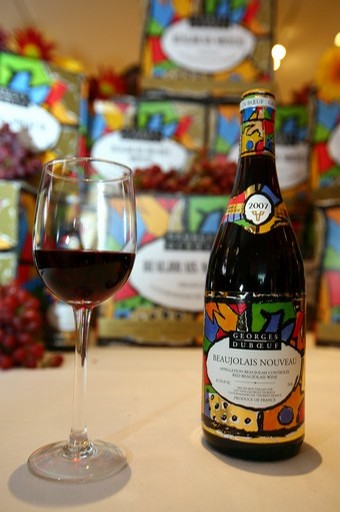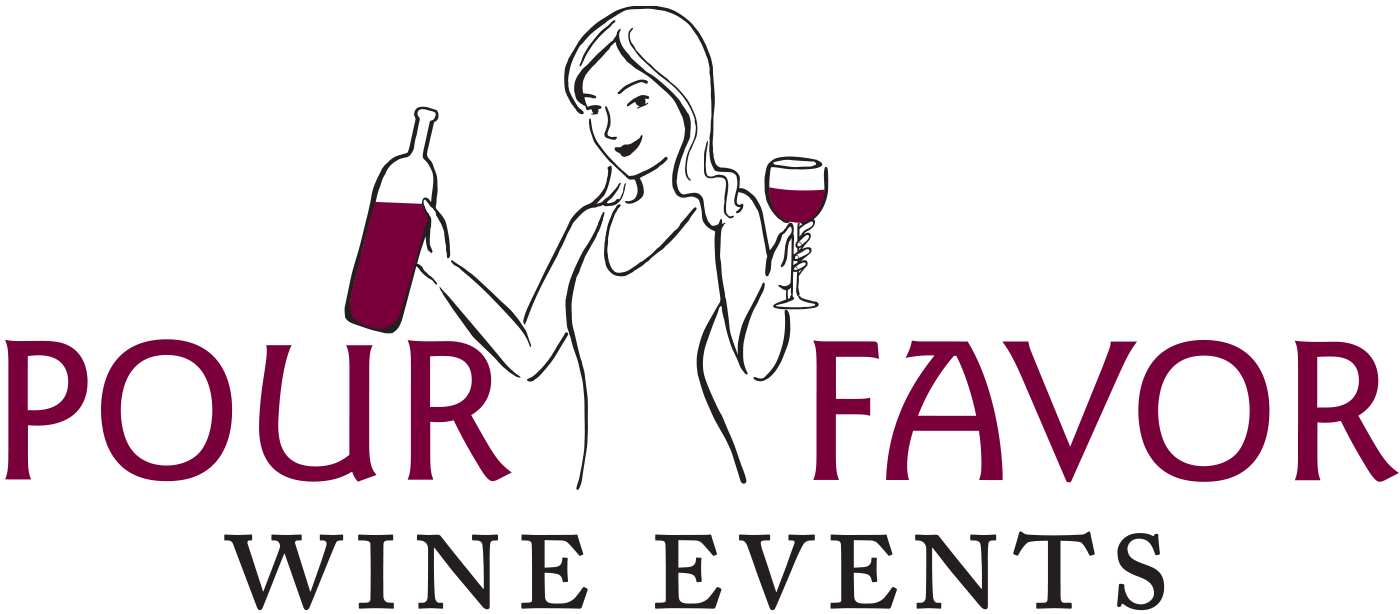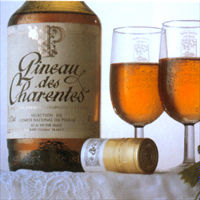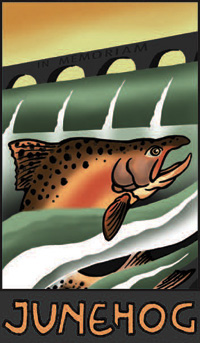 Before Harry Potter book signing parties, there were other parties, wine parties, that came more frequently than those of the Harry Potter variety. They came every 3rd Thursday in November to be precise. And the tradition lives on....
Just one week before Thanksgiving stacks of the colorful Georges Duboeuf's famous Beaujolais Nouveau are sent out to wine shops from Beaujolais, France (think Southern Burgundy where Pinot Noir thrives). Wondered what it is? Beaujolais is a wine made from a grape called Gamay. The Nouveau style is made through a fermentation process called carbonic maceration and is released super-duper fresh, i.e. from harvest to bottle to market within mere weeks! It is intended consumers drink this wine young, and certainly no longer than 6 months. Why? Well, Gamay is a low-tannin varietal, which makes it optimal for those who prefer a light-styled, fruity, fruity wine. But even with it's naturally high acidity (another "age-worthy" component for wine), the fact that the wine goes through carbonic maceration hurts the wine's natural ability to age.
Before Harry Potter book signing parties, there were other parties, wine parties, that came more frequently than those of the Harry Potter variety. They came every 3rd Thursday in November to be precise. And the tradition lives on....
Just one week before Thanksgiving stacks of the colorful Georges Duboeuf's famous Beaujolais Nouveau are sent out to wine shops from Beaujolais, France (think Southern Burgundy where Pinot Noir thrives). Wondered what it is? Beaujolais is a wine made from a grape called Gamay. The Nouveau style is made through a fermentation process called carbonic maceration and is released super-duper fresh, i.e. from harvest to bottle to market within mere weeks! It is intended consumers drink this wine young, and certainly no longer than 6 months. Why? Well, Gamay is a low-tannin varietal, which makes it optimal for those who prefer a light-styled, fruity, fruity wine. But even with it's naturally high acidity (another "age-worthy" component for wine), the fact that the wine goes through carbonic maceration hurts the wine's natural ability to age.
The hoopla of this catch-and-release process began in the late 1800s. Locals recognized this light-styled red wine was perfect for the transition between seasons and the unofficial 'switch' from white to red wine drinking - and they made a party of it (just imagine! pitchers of wine from the barrels were on offer!!) while the more grand Beaujolais wines were still working their mojo and evolving. The French government decided to reign in the revelry a little bit in 1938 and then in 1951 declared the "3rd Thursday in November" rule.
I don't mean to mislead you, however. Georges Duboeuf isn't the only producer of Beauojolais Nouveau; he's just the most famous because he produces so much of the stuff. Regardless who's Nouveau you select to sip, expect tooty-fruity red berry flavors. It's not my bag, though I have come to appreciate Beaujolais/Gamay when on offer from one of the premiere villages where the wine hasn't been quite as fast-tracked, e.g. Moulin-a-Vent, Morgon, Fleurie and Brouilly. Those wines tend to offer a bit more complexity - a touch of earth, a touch more depth, and a touch of tannin to offset all of that boisterous fruit! Their light style, much like Pinot Noir, is indeed a great complement to your turkey dinner.
So the question is... will you Nouveau?


 I was raised in a family where asking someone about finances - or their buying power - might be considered a little too forward. But one of the most helpful questions I've learned to ask a customer searching for the "perfect" bottle is "how much do you want to spend?". I'm sure I've said it before: there is a ton of great juice on the market. Knowing how much someone wants to spend helps me narrow the playing field and help them find a great bottle to suit the occasion.
Often I meet people who know they want to bring a bottle to dinner, but feel uncomfortable with wine and don't feel they know what is an appropriate amount for a "good" bottle of wine for X occasion. A good salesperson will be able to steer you in the right direction - without making you feel uncomfortable. But failing that ideal experience, here are a few things to consider when shopping (particularly given the economic climate and the upcoming holidays).
I was raised in a family where asking someone about finances - or their buying power - might be considered a little too forward. But one of the most helpful questions I've learned to ask a customer searching for the "perfect" bottle is "how much do you want to spend?". I'm sure I've said it before: there is a ton of great juice on the market. Knowing how much someone wants to spend helps me narrow the playing field and help them find a great bottle to suit the occasion.
Often I meet people who know they want to bring a bottle to dinner, but feel uncomfortable with wine and don't feel they know what is an appropriate amount for a "good" bottle of wine for X occasion. A good salesperson will be able to steer you in the right direction - without making you feel uncomfortable. But failing that ideal experience, here are a few things to consider when shopping (particularly given the economic climate and the upcoming holidays).
 A few weeks ago I stumbled upon a rare treat in the larger wine world, particularly here in North America: Pineau des Charentes. When I saw that
A few weeks ago I stumbled upon a rare treat in the larger wine world, particularly here in North America: Pineau des Charentes. When I saw that  Ok, readers! Buckle up, because here IT is....
Over the weekend I was in NYC visiting my sister and some friends. Saturday night we headed out for a somewhat low-key night of good old fashioned catching up. After we wrapped up our meal, we decided to check out one of the 3 different wine bars that has popped up in my sister's neighborhood in recent months. It was a great scene - low lighting, a phenomenally long, graceful bar, terrific bar snacks, a loungey thing going around us and in a back room....
Ok, readers! Buckle up, because here IT is....
Over the weekend I was in NYC visiting my sister and some friends. Saturday night we headed out for a somewhat low-key night of good old fashioned catching up. After we wrapped up our meal, we decided to check out one of the 3 different wine bars that has popped up in my sister's neighborhood in recent months. It was a great scene - low lighting, a phenomenally long, graceful bar, terrific bar snacks, a loungey thing going around us and in a back room....
 Stumbled across a wine lately that sang a familiar tune but offered s o m u c h m o r e than the same old same old?
I find this happens when I least expect it - and often enough when the grapes involved in the winemaking process are local, or native to the area from whence they're grown. We talked about
Stumbled across a wine lately that sang a familiar tune but offered s o m u c h m o r e than the same old same old?
I find this happens when I least expect it - and often enough when the grapes involved in the winemaking process are local, or native to the area from whence they're grown. We talked about  I realized it was time to get back in the Entertaining Saddle as soon as the Red Sox lost the ALCS. Football is great, don't get me wrong, but we're only talking about 2 days of Go Time each week. And with my favorite cooking magazine,
I realized it was time to get back in the Entertaining Saddle as soon as the Red Sox lost the ALCS. Football is great, don't get me wrong, but we're only talking about 2 days of Go Time each week. And with my favorite cooking magazine, 
 White wines aren't just a summer thang. (One of the best turkey wines is actually
White wines aren't just a summer thang. (One of the best turkey wines is actually